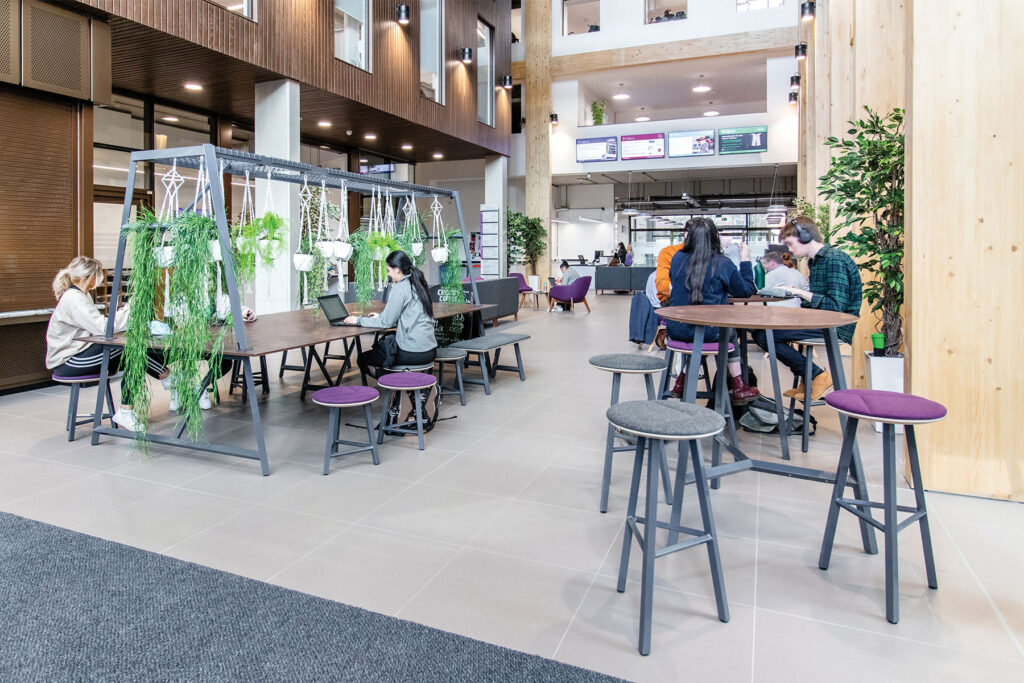Create a better working environment by understanding how to design for neurodiverse teams.
Neurodivergence can encompass a range of conditions including Autism, Attention Deficit Disorders, Dyslexia, and Dyspraxia. It’s estimated more than 15% of the UK are neurodivergent, meaning that their brain functions in a way that means they learn, process and experience the world differently from what is considered ‘typical’.
Those who identify as neurodivergent can often have incredible skills that make them an asset to the workplace like strong attention to detail or unique, ‘out of the box’ thinking. While they have these incredible skills to offer, navigating a neurotypical world can be difficult, leading to stress and burnout.
By making intelligent design adjustments, the workplace can support neurodivergent employees to feel well and perform their best. When spaces are designed inclusively, everyone can benefit, no matter their neurotype.
Adjustments
One of the best ways to approach inclusivity for neurodivergent people is considering sensory input. This means that you make changes to alleviate stress caused by the external environment on our senses (sight, hearing, smell, and touch).
Visual
Lighting can be a source of discomfort for many people with flickering or bright lighting often being reported as an issue.
To remedy this, opt for occupant lighting control – these lighting strategies take into account personal preferences of users and their interaction with the physical space. Our Task Light is a great choice for occupant lighting control, with three lighting modes to be adjusted to the users preference.

As well as artificial lighting, strong sunlight can also be problematic. To help, use plain blinds that block out the light effectively – curtains or blinds that throw patterns can still cause distractions.
People can also often be sensitive to busy patterns and bold colours. Instead, opt for décor with low contrast patterns or block colours in muted tones.
To assist individuals who struggle with orientation, provide simple signage with clear graphics and colour coding. Include a neat spacious layout to make navigation simpler and make the space easier on the eyes. You should also try to break free from visual monotony by avoiding too much repetition in the design and making it easier to identify your surroundings.
Similar techniques can also be useful for those with organisational difficulties. For example, clearly labelled shelving and storage, or whiteboards to visualise tasks can help.

Aural
Some sounds can cause discomfort or make concentrating difficult, particularly if they are loud. While noise cancelling headphones can be useful, there are other design considerations you could use to help.
Zoning can be a useful way to create separate spaces and adjust for noise. Try and create shielded spaces for quiet working away from crowded or noisy areas. A great example of this is Colony, which creates clear boundaries and offers a warm inviting space. Colony is great for offering space away from the main flow of ‘traffic’ which can be relieving if social interaction can be overwhelming, or the general hubbub of an office can get too much.
Learn more about the importance of offering space for quiet time.

Many neurodivergent people cite the hum of electrical equipment as a cause of stress and distraction. Try and choose the quietest possible appliances and consider where they are placed. It can also be helpful to set them to turn off completely when not in use.
Another solution for auditory issues can be to choose soft furnishings with fabrics that help absorb noise. Cork can also be a great material for absorbing sound and reducing acoustic noise. This can make the space quieter and less echoey, and in turn easier to process.
Cork also offers the benefits of being an environmentally sustainable material that offers flexibility in it’s usage. For example, our Grow cork stool are perfect for those who require a lot of stimulation and like to work in different areas of the space.

Olfactory
Unexpected odours can be another cause of discomfort. One key way to help with this is by keeping working areas separate from toilets, kitchen areas and bins.
It’s also beneficial to cultivate good air quality to help smells dissipate and reduce harmful Volatile Organic Compounds (VOCs). Choose products that have been tested for their VOC offset levels to reduce their impact on indoor air quality. Learn more about Volatile Organic Compound Reductions here.
You can also improve air quality with air purifying plants such as areca palm or snake plants which absorb toxins and release more oxygen into the room. Use furniture in your space that allows you to be creative with your plants, like the Osti Cloud and Relic Cloud which incorporate canopies for biophilia.

Tactile
Consider the materials that you are using and choose options that are softer and comfortable. Rough, scratchy textures can be overstimulating, while soft, smooth textures can be comforting.
Some neurodivergent people like to ‘stim’, this is where they repeat behaviours to self-soothe or simply because it’s enjoyable. The textures around them can be a big part of that, for example fidgeting with small items or stroking a smooth surface like bamboo can be relaxing.
Frövi furniture comes in a wide variety of materials and finishes and offers you choice to create unique variations on our products.
Finally, you may want to offer different spaces for different ways of working – some people come up with their best ideas when they’re able to pace or bounce ideas off colleagues, while others prefer soft, quiet spaces by themselves. This can even vary from day to day, so it’s important to utilise the space with intelligent furniture. Learn more about how to design an agile office space.
The world of work is changing for the better to be more inclusive, and by making some simple adjustments you can help the workplace thrive.

